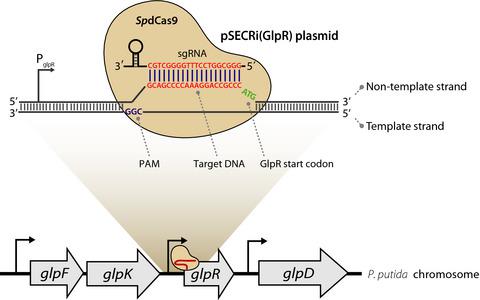当前位置:
X-MOL 学术
›
Microb. Biotechnol.
›
论文详情
Our official English website, www.x-mol.net, welcomes your
feedback! (Note: you will need to create a separate account there.)
CRISPR interference-mediated gene regulation in Pseudomonas putida KT2440.
Microbial Biotechnology ( IF 4.8 ) Pub Date : 2019-02-22 , DOI: 10.1111/1751-7915.13382 Seong Keun Kim 1 , Paul K Yoon 1 , Soo-Jung Kim 1 , Seung-Gyun Woo 1, 2 , Eugene Rha 1 , Hyewon Lee 1 , Soo-Jin Yeom 1 , Haseong Kim 1, 2 , Dae-Hee Lee 1, 2 , Seung-Goo Lee 1, 2
Microbial Biotechnology ( IF 4.8 ) Pub Date : 2019-02-22 , DOI: 10.1111/1751-7915.13382 Seong Keun Kim 1 , Paul K Yoon 1 , Soo-Jung Kim 1 , Seung-Gyun Woo 1, 2 , Eugene Rha 1 , Hyewon Lee 1 , Soo-Jin Yeom 1 , Haseong Kim 1, 2 , Dae-Hee Lee 1, 2 , Seung-Goo Lee 1, 2
Affiliation

|
Targeted gene regulation is indispensable for reprogramming a cellular network to modulate a microbial phenotype. Here, we adopted the type II CRISPR interference (CRISPRi) system for simple and efficient regulation of target genes in Pseudomonas putida KT2440. A single CRISPRi plasmid was generated to express a nuclease‐deficient Cas9 gene and a designed single guide RNA, under control of l‐rhamnose‐inducible PrhaBAD and the constitutive Biobrick J23119 promoter respectively. Two target genes were selected to probe the CRISPRi‐mediated gene regulation: exogenous green fluorescent protein on the multicopy plasmid and endogenous glpR on the P. putida KT2440 chromosome, encoding GlpR, a transcriptional regulator that represses expression of the glpFKRD gene cluster for glycerol utilization. The CRISPRi system successfully repressed the two target genes, as evidenced by a reduction in the fluorescence intensity and the lag phase of P. putida KT2440 cell growth on glycerol. Furthermore, CRISPRi‐mediated repression of glpR improved both the cell growth and glycerol utilization, resulting in the enhanced production of mevalonate in an engineered P. putida KT2440 harbouring heterologous genes for the mevalonate pathway. CRISPRi is expected to become a robust tool to reprogram P. putida KT2440 for the development of microbial cell factories producing industrially valuable products.
中文翻译:

恶臭假单胞菌KT2440中的CRISPR干扰介导的基因调控。
靶向基因调节对于重新编程细胞网络以调节微生物表型必不可少。在这里,我们采用II型CRISPR干扰(CRISPRi)系统来简单有效地调节恶臭假单胞菌KT2440中的靶基因。生成了一个CRISPRi质粒来表达核酸酶缺陷的Cas9基因和一个设计的单个向导RNA,分别在l-鼠李糖诱导的P rha BAD和本构性Biobrick J23119启动子的控制下。选择了两个靶基因来探索CRISPRi介导的基因调控:多拷贝质粒上的外源绿色荧光蛋白和恶臭假单胞菌上的内源性glpRKT2440染色体,编码GlpR,一种转录调节因子,可抑制glpFKRD基因簇的表达以利用甘油。CRISPRi系统成功抑制了两个靶基因,这是由荧光强度和恶臭假单胞菌KT2440细胞在甘油上生长的滞后期减少所证明的。此外,CRISPRi介导的glpR抑制可改善细胞生长和甘油利用,从而导致在工程化的恶臭假单胞菌KT2440中含有甲羟戊酸途径的异源基因,从而增加了甲羟戊酸的产量。CRISPRi有望成为重编程恶臭假单胞菌的强大工具KT2440用于开发生产工业价值产品的微生物细胞工厂。
更新日期:2019-02-22
中文翻译:

恶臭假单胞菌KT2440中的CRISPR干扰介导的基因调控。
靶向基因调节对于重新编程细胞网络以调节微生物表型必不可少。在这里,我们采用II型CRISPR干扰(CRISPRi)系统来简单有效地调节恶臭假单胞菌KT2440中的靶基因。生成了一个CRISPRi质粒来表达核酸酶缺陷的Cas9基因和一个设计的单个向导RNA,分别在l-鼠李糖诱导的P rha BAD和本构性Biobrick J23119启动子的控制下。选择了两个靶基因来探索CRISPRi介导的基因调控:多拷贝质粒上的外源绿色荧光蛋白和恶臭假单胞菌上的内源性glpRKT2440染色体,编码GlpR,一种转录调节因子,可抑制glpFKRD基因簇的表达以利用甘油。CRISPRi系统成功抑制了两个靶基因,这是由荧光强度和恶臭假单胞菌KT2440细胞在甘油上生长的滞后期减少所证明的。此外,CRISPRi介导的glpR抑制可改善细胞生长和甘油利用,从而导致在工程化的恶臭假单胞菌KT2440中含有甲羟戊酸途径的异源基因,从而增加了甲羟戊酸的产量。CRISPRi有望成为重编程恶臭假单胞菌的强大工具KT2440用于开发生产工业价值产品的微生物细胞工厂。











































 京公网安备 11010802027423号
京公网安备 11010802027423号